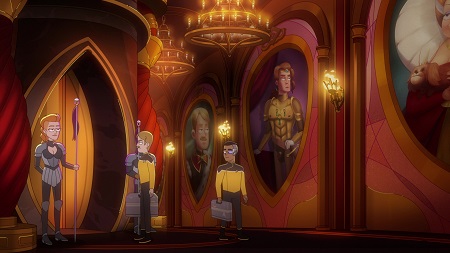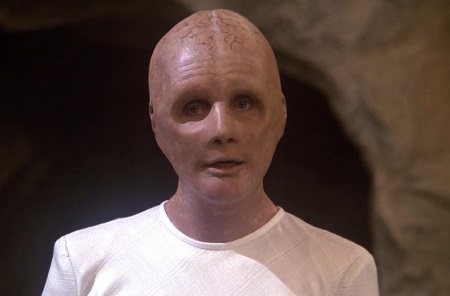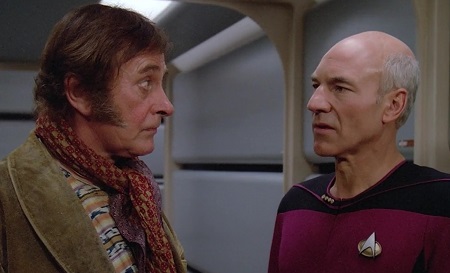
Spoiler Warning: There are spoilers ahead for Star Trek: Lower Decks Seasons 1-2 and for the following Star Trek productions: Discovery Season 2, The Original Series, The Next Generation, and Enterprise.
Star Trek: Lower Decks hasn’t lent itself to a lot of theorising thus far! The episodic nature of the show and humorous tone have seen a lot of one-and-done stories, as well as stories that draw on Star Trek’s existing lore and history rather than adding to our understanding of how life in the Star Trek galaxy works. And that’s fine – it’s a great show, one which generally succeeds at capturing the essence of Star Trek while showing a more amusing side to life in Starfleet.
Last week’s episode, Where Pleasant Fountains Lie, has led me to craft a theory, though, and it’s one that connects to events right at the beginning of the Star Trek franchise, back in the days of The Original Series. In short: have you ever wondered why Captain Kirk and his crew seemed to encounter a lot of “aliens” who were indistinguishable from modern humans? It’s possible – at least according to this theory – that Lower Decks might have just provided us with a plausible in-universe explanation!

Before we look at either Lower Decks or The Original Series, we need to take a detour to Season 6 of The Next Generation. The episode The Chase attempted to provide an in-universe explanation for the apparent abundance of similar humanoid races in the Star Trek galaxy: the interference of an extinct race of ancient humanoids, who “seeded” worlds across the Alpha and Beta Quadrants with their genetic material, essentially acting as forerunners or ancestors to Cardassians, Vulcans, Romulans, Klingons, humans, and perhaps many other races.
Just like the Klingon augment virus in Enterprise, or the warp speed limit from Season 7 of The Next Generation, this seemingly huge revelation about the ancient history of the Star Trek galaxy has been entirely ignored since the episode in which it first appeared, not even getting so much as a mention in the hundreds of other stories that have been produced since. That isn’t to say this explanation is wrong or landed poorly in the fandom, but as often happens when an episodic series introduces a major story point, writers who came along later either didn’t know what to do with it or didn’t want to explore it further. Thus the ancient humanoid story is a self-contained one that doesn’t have a great deal of bearing on the wider Star Trek galaxy – though fans can, of course, choose to interpret the presence of humanoids through the lens of The Chase.

But The Chase only provided an explanation for the existence of humanoids – Klingons, Romulans, humans, etc. What it doesn’t really explain in any detail is the existence of species that are anatomically and visually indistinguishable from humans, and The Original Series featured plenty of those! For example, we have the people of the planet Gideon (from The Mark of Gideon), the Betans (from The Return of the Archons and later seen in Lower Decks Season 1), the Iotians (from A Piece of the Action), the people of the planet 892-IV (from Bread and Circuses), and the Earth Two natives (a.k.a. Miri’s species, from the episode Miri). All of these races – and many more – are completely identical to humans.
Most of the aforementioned peoples were treated in their original appearances as being non-humans, natives of whichever planet the Enterprise was visiting that week. But it certainly raises some questions, especially considering that other alien races could be at least superficially different: the Bajorans have distinctive noses, the Vulcans and Romulans have their ears, and so on. How or why did the inhabitants of these worlds come to be indistinguishable from humans – is life in the galaxy somehow predisposed to evolve into this precise form? The Chase offers half of an explanation, but even then it isn’t perfect. Enter last week’s episode of Lower Decks: Where Pleasant Fountains Lie.

Andy Billups, chief engineer of the USS Cerritos, is human. But he isn’t a native of Earth, nor of any Federation member world – his people are the Hysperians, a group of humans from the planet Hysperia who had constructed a society modelled around a medieval-fantasy/renaissance fair lifestyle and aesthetic. The important thing to note is that the Hysperians appear to be independent of the Federation, with their own monarchy, laws, culture, and fleet of starships. Though on friendly terms with Starfleet, the Hysperians appear to exist independently of the Federation.
So Where Pleasant Fountains Lie has confirmed that human colonies existed outside of the jurisdiction of the Federation. We knew that already, having seen worlds like Turkana IV (homeworld of Tasha Yar) in The Next Generation, but Where Pleasant Fountains Lie expanded our understanding of non-Federation humans. It seems as though the Hysperians – or their ancestors, at least – shared a common love for fantasy, magic, and a medieval/renaissance fair lifestyle, and set out to establish their own colony on that basis.

Another episode from The Next Generation is important here: Season 2’s Up The Long Ladder. This episode introduced two colonies of humans – the Bringloidi and the Mariposans. The former were a group of luddites; Irish colonists who disliked the use of technology. The latter were a group of scientists, clones of the original colonists. The important thing to note for the purposes of this theory is that the Federation was unaware of the existence of either colony until the Enterprise-D made contact with them in the mid-24th Century. For more than two centuries, both colonies were completely unknown.
So now we come to the heart of the theory that was inspired by Where Pleasant Fountains Lie. Suppose a colony like Hysperia had been established centuries ago, but contact had been lost. If the Federation were to encounter the Hysperians for the first time, they would seem like an entirely different people at first, as they have their own distinctive culture, system of government, and starship designs. They don’t appear to be at all similar to modern Federation humans as of the late 24th Century, and it’s only because their colony’s origins are known to us as the audience and to Starfleet that we treat them as an offshoot of humanity and not as an entirely distinct people.

Here’s the theory, then, in its condensed form: the peoples Captain Kirk met during The Original Series that are identical to humans are, in fact, lost human colonies. Just like the Bringloidi and Mariposans, their records have been lost or their destinations not recorded, but at some point in the past they left Earth, established new homes for themselves, and developed their own cultures and ways of doing things.
Some of these peoples could even be the descendants of abductees, such as those encountered in the Voyager episode The 37’s or Enterprise’s North Star. The humans saved by the Red Angel and transported across the galaxy that Captain Pike and Michael Burnham encountered in the Discovery Season 2 episode New Eden were developing independently of the Federation in the mid-23rd Century, and Pike even instructed his crew that the Prime Directive applied when dealing with the inhabitants of Terralysium.

Just like the Hysperians chose to build their society around a fantasy/renaissance fair-inspired aesthetic and setting, maybe some of these lost colonies likewise had the intention of building a world based around shared likes and interests. Perhaps the original colonists of 892-IV were big fans of Ancient Rome and deliberately created a Roman-inspired society. Perhaps Miri’s ancestors terraformed their world to make it resemble Earth. Gideon may be an Earth colony that got out of control, similar to Turkana IV. Or, as we see in episodes like North Star and New Eden, perhaps peoples abducted at a point in the past tried to recreate the societies from which they came.
I’ve never been a big fan of the ancient humanoids from The Chase as an explanation for the prevalence of humanoids in the Star Trek galaxy. I don’t think the fact that Klingons, Cardassians, and humans are all two-legged, two-armed, air-breathing beings of similar heights and builds was something that needed this kind of in-universe explanation; it was enough to leave it unsaid that the galaxy is populated by humanoid aliens. Trying to provide an explanation actually led to over-explaining and drawing unnecessary attention to it.

But when it comes to aliens that are identical to humans, the explanation from The Chase only goes so far. If we try to argue that the abundance of human-looking aliens is caused by the meddling of ancient humanoids who also caused the evolution of the Klingons, Vulcans, Cardassians, etc. then the obvious question is why are there not dozens of Cardassian-looking aliens, or Klingon-oids?
Instead, what we could say is that these peoples are more likely to be lost Earth colonies. Just like the Bringloidi and the Mariposans, knowledge of their existence was lost in between their departures from Earth and their encounters with Captain Kirk. If we take The Original Series episode Space Seed at face value, humans had been able to launch large spacecraft since at least the late 20th Century, and with World War III taking place in the mid-21st Century, it’s possible that the records of thousands of space launches were lost. Just like Khan and his followers set out from Earth, perhaps the ancestors of some of these peoples did as well. Some may also be the descendants of humans abducted by aliens in the distant past, and this could explain how some humans have existed independently of Earth for centuries or millennia.

So that’s the extent of this theory, really! I think it provides an interesting alternative explanation as to why Captain Kirk encountered so many human-looking “aliens” during The Original Series. We could even potentially extend this theory to include races like the Betazoids.
Obviously the reason why so many aliens in Star Trek, particularly in the franchise’s early days, were identical to humans was because of limitations in budget and special effects. But that doesn’t have to be the end of it! We can craft intricate theories, partly based on things we’ve learned in other iterations of the franchise, to go back and explain these things. To me at least, the idea that races like the Iotians, Fabrini, and Betans are in fact lost offshoots of humanity makes more sense than the idea that they naturally evolved to be indistinguishable from humans.
Star Trek: Lower Decks Season 2 is available to stream now on Paramount+ in the United States, and on Amazon Prime Video in the UK and around the world. The Star Trek franchise – including Lower Decks and all other properties mentioned above – is the copyright of ViacomCBS. This article contains the thoughts and opinions of one person only and is not intended to cause any offence.


